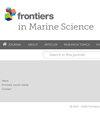饲料中不同鱼粉水平对草鱼生长性能、组织形态、肠道菌群和肌肉挥发性物质的影响
IF 3
2区 生物学
Q1 MARINE & FRESHWATER BIOLOGY
引用次数: 0
摘要
鱼粉有利于草鱼的生长性能。然而,目前尚不清楚鱼粉是否可以增强肌肉的风味,并参与其与肠道微生物群相互作用的调节机制。方法以草鱼(70.01±5.34 g)为试验对象,分别饲喂鱼粉含量为0% (FL)、3% (FM)和6% (FH)的饲料60 d。对生长性能、肠道和肌肉组织形态学、肠道菌群和肌肉挥发性化合物(VOCs)进行了评价。结果表明,与鱼粉组相比,鱼粉组和鱼粉组草鱼的末重(FBW)、增重率(WGR)、特定生长率(SGR)和肠绒毛高度均显著提高。与鱼粉组和鱼粉组相比,鱼粉组肌纤维密度显著增加,肌纤维直径显著减小。微生物数据分析发现,3个处理组在NMDS地块上分离良好,不同水平的鱼粉对微生物群落组成有显著影响(Stress = 0.084)。在LefSe分析(LDA值&;gt; 3.0)中,FL组的放线菌、FM组的petronas、FH组的paurosaccharolyticus Bacteroides、丹毒杆菌科(Erysipelatostridiaceae)均有显著的反应。与鱼粉组相比,鱼粉组和鱼粉组肠道菌群组成更接近。GC-IMS分析表明,肌肉中检测到53种挥发性有机化合物。FL组VOCs含量较低,且大部分VOCs含量低于FH组。Spearman相关分析显示,醛类与棒状杆菌、拟杆菌、鲸杆菌、丹毒弧菌、气单胞菌、希瓦氏菌和弧菌呈显著正相关。通过对生长性能、肠道形态和微生物区系的评价,确定3%鱼粉为适宜饲料。但6%鱼粉组草鱼的肌纤维特性和VOCs分布优于3%鱼粉组。本文章由计算机程序翻译,如有差异,请以英文原文为准。
Effect of different fishmeal levels in diets on growth performance, tissue morphology, intestinal microflora, and muscle volatile compounds of grass carp
IntroductionFishmeal is beneficial to the growth performance of grass carp. However, it remains unclear whether fishmeal can enhance the flavor of muscle, and contribute to the regulatory mechanisms involved in its interaction with the intestinal microbiome.MethodsIn this study, grass carp (70.01 ± 5.34 g) were fed with diets containing 0% (FL), 3% (FM), and 6% (FH) fishmeal for 60 days. The growth performance, intestinal and muscle histomorphology, intestinal microflora, and muscle volatile compounds (VOCs) were evaluated.ResultsThe results showed that compared with the FL group, the final body weight (FBW), weight gain rate (WGR), specific growth rate (SGR), and intestinal villus height of grass carp in the FM and FH groups were significantly increased. Compared with the FL and FM groups, the muscle fiber density in the FH group was significantly increased, and the muscle fiber diameter was significantly reduced. Microbial data analysis found that the three treatment groups were well separated in the NMDS plot, and different levels of fishmeal had a significant impact on microbial community composition (Stress = 0.084). In the LefSe analysis (LDA value > 3.0), Actinobacteria in the FL group, Petrimonas in the FM group, Bacteroides paurosaccharolyticus , and Erysipelatostridiaceae in the FH group all showed significant responses. The intestinal microbiota composition was closer in the FM and FH groups compared with the FL group. GC-IMS analysis indicated that 53 VOCs were detected in the muscle. The FL group had fewer VOCs, and most of the VOCs had lower contents than those in the FH group. Spearman correlation analysis showed that aldehydes were significantly positively correlated with Corynebacterium, Bacteroides, Cetobacterium, Erysipelatoclostridium, Aeromonas, Shewanella , and Vibrio .DiscussionBased on the evaluation of growth performance, intestinal morphology, and microflora, the diet containing 3% fishmeal is suitable. However, the muscle fiber characteristics and VOCs profile of grass carp fed with 6% fishmeal diet is superior to that of the 3% fishmeal group.
求助全文
通过发布文献求助,成功后即可免费获取论文全文。
去求助
来源期刊

Frontiers in Marine Science
Agricultural and Biological Sciences-Aquatic Science
CiteScore
5.10
自引率
16.20%
发文量
2443
审稿时长
14 weeks
期刊介绍:
Frontiers in Marine Science publishes rigorously peer-reviewed research that advances our understanding of all aspects of the environment, biology, ecosystem functioning and human interactions with the oceans. Field Chief Editor Carlos M. Duarte at King Abdullah University of Science and Technology Thuwal is supported by an outstanding Editorial Board of international researchers. This multidisciplinary open-access journal is at the forefront of disseminating and communicating scientific knowledge and impactful discoveries to researchers, academics, policy makers and the public worldwide.
With the human population predicted to reach 9 billion people by 2050, it is clear that traditional land resources will not suffice to meet the demand for food or energy, required to support high-quality livelihoods. As a result, the oceans are emerging as a source of untapped assets, with new innovative industries, such as aquaculture, marine biotechnology, marine energy and deep-sea mining growing rapidly under a new era characterized by rapid growth of a blue, ocean-based economy. The sustainability of the blue economy is closely dependent on our knowledge about how to mitigate the impacts of the multiple pressures on the ocean ecosystem associated with the increased scale and diversification of industry operations in the ocean and global human pressures on the environment. Therefore, Frontiers in Marine Science particularly welcomes the communication of research outcomes addressing ocean-based solutions for the emerging challenges, including improved forecasting and observational capacities, understanding biodiversity and ecosystem problems, locally and globally, effective management strategies to maintain ocean health, and an improved capacity to sustainably derive resources from the oceans.
 求助内容:
求助内容: 应助结果提醒方式:
应助结果提醒方式:


